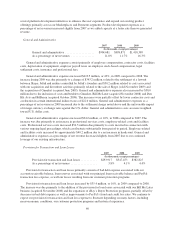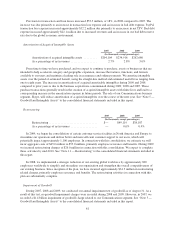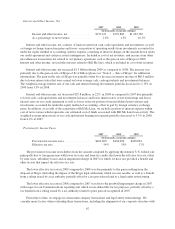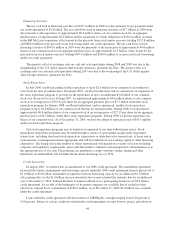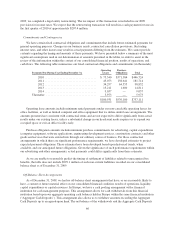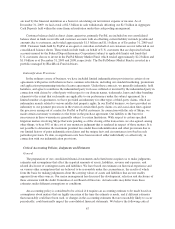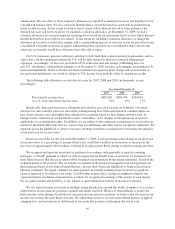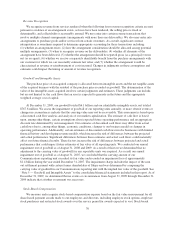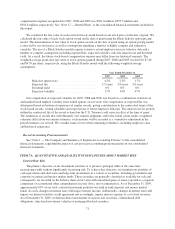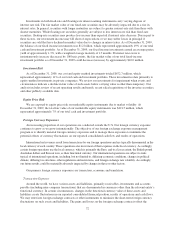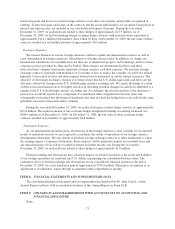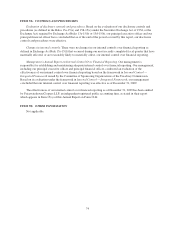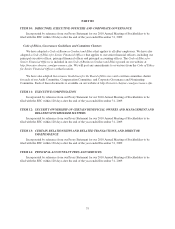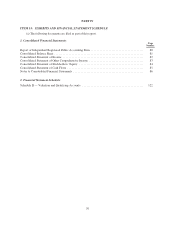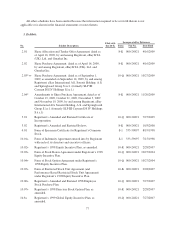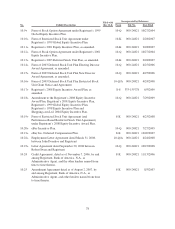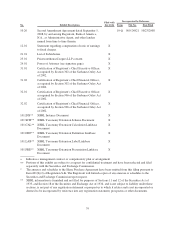eBay 2009 Annual Report Download - page 77
Download and view the complete annual report
Please find page 77 of the 2009 eBay annual report below. You can navigate through the pages in the report by either clicking on the pages listed below, or by using the keyword search tool below to find specific information within the annual report.
amortization. The tax effect of these temporary differences is reported as deferred tax assets and liabilities in our
consolidated balance sheet. We also assess the likelihood that our net deferred tax assets will be realized from
future taxable income. To the extent we believe that it is more likely than not that all or some portion or the
deferred tax asset will not be realized, we establish a valuation allowance. At December 31, 2009, we had a
valuation allowance on certain foreign net operating losses based on our assessment that it is more likely than not
that the deferred tax asset will not be realized. To the extent we establish a valuation allowance or change the
allowance in a period, we reflect the change with a corresponding increase or decrease in our tax provision in our
consolidated statement of income or against additional paid-in-capital in our consolidated balance sheet to the
extent any tax benefits would have otherwise been allocated to equity.
Our U.S. businesses generate sufficient cash flow to fully fund their current operating requirements, and we
expect that cash flow generated outside the U.S. will be fully utilized to fund our continued international
expansion. Accordingly, we have not provided for U.S. federal income and foreign withholding taxes on
non-U.S. subsidiaries’ undistributed earnings as of December 31, 2009, because such earnings are intended to be
reinvested indefinitely. In the event that our future international expansion plans change and such amounts are
not reinvested indefinitely, we would be subject to U.S. income taxes partially offset by foreign tax credits.
The following table illustrates our effective tax rates for 2007, 2008 and 2009 (in thousands, except
percentages):
Year Ended December 31,
2007 2008 2009
Provision for income taxes ...................... $402,600 $404,090 $490,054
As a % of income before income taxes ............ 54% 19% 17%
Historically, these provisions have adequately provided for our actual income tax liabilities. Our future
effective tax rates could be adversely affected by earnings being lower than anticipated in countries where we
have lower statutory rates and higher than anticipated in countries where we have higher statutory rates, by
changes in the valuations of our deferred tax assets or liabilities, or by changes or interpretations in tax laws,
regulations or accounting principles. In addition, we are subject to the continuous examination of our income tax
returns by the Internal Revenue Service, various state tax authorities and other various foreign tax authorities. We
regularly assess the likelihood of adverse outcomes resulting from these examinations to determine the adequacy
of our provision for income taxes.
Based on our results for the year ended December 31, 2009, a one-percentage point change in our provision
for income taxes as a percentage of income before taxes would have resulted in an increase or decrease in the
provision of approximately $28.8 million, resulting in an approximate $0.02 change in diluted earnings per share.
We recognize and measure uncertain tax positions in accordance with generally accepted accounting
principles, or GAAP, pursuant to which we only recognize the tax benefit from an uncertain tax position if it is
more likely than not that the tax position will be sustained on examination by the taxing authorities, based on the
technical merits of the position. The tax benefits recognized in the financial statements from such positions are
then measured based on the largest benefit that has a greater than 50 percent likelihood of being realized upon
ultimate settlement. We report a liability for unrecognized tax benefits resulting from uncertain tax positions
taken or expected to be taken in a tax return. GAAP further requires that a change in judgment related to the
expected ultimate resolution of uncertain tax positions be recognized in earnings in the quarter of such change.
We recognize interest and penalties, if any, related to unrecognized tax benefits in income tax expense.
We file annual income tax returns in multiple taxing jurisdictions around the world. A number of years may
elapse before an uncertain tax position is audited and finally resolved. While it is often difficult to predict the
final outcome or the timing of resolution of any particular uncertain tax position, we believe that our reserves for
income taxes reflect the most likely outcome. We adjust these reserves, as well as the related interest, in light of
changing facts and circumstances. Settlement of any particular position could require the use of cash.
69



